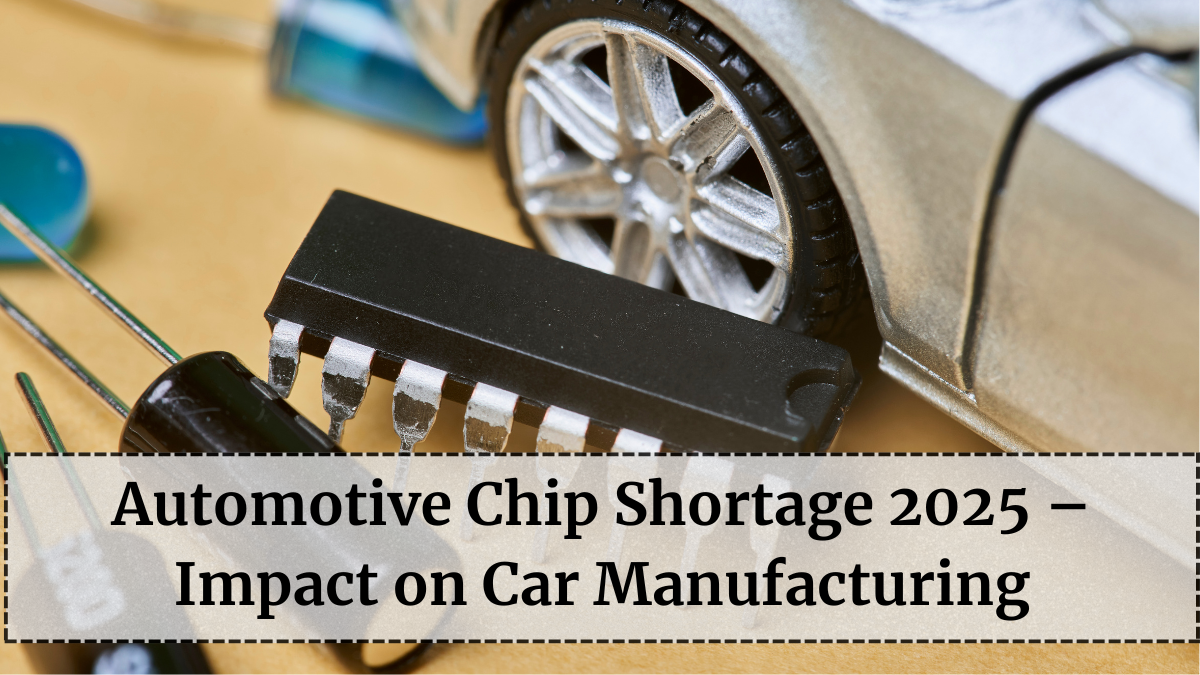The global semiconductor shortage that started in 2020 is still leaving its mark on the automobile industry in 2025. While the world has largely recovered from pandemic-era disruptions, automakers continue to face chip supply imbalances that are delaying production, raising costs, and forcing innovation in how vehicles are designed.
Chips have become the new fuel for modern vehicles — powering everything from infotainment screens and ADAS systems to battery management and connectivity. Without them, even the most advanced cars can’t roll off the assembly line.
Let’s break down how the automotive chip shortage continues to affect the industry in 2025 and how companies are navigating this new technological bottleneck.

Why Chips Are So Important in Cars
The Rise of Smart and Electric Vehicles
A decade ago, a car used around 200 microchips. Today’s electric and connected cars use more than 3,000 chips, controlling everything from power distribution to safety features like automatic braking.
Modern systems such as autonomous driving, infotainment, and EV battery control units rely heavily on semiconductors. With increasing demand for smart features, the industry’s chip dependency has reached an all-time high.
Types of Automotive Chips
-
Microcontrollers (MCUs): Manage sensors and vehicle logic.
-
Power Semiconductors: Regulate electric flow for EV motors.
-
Infotainment SoCs: Power digital displays and entertainment units.
-
ADAS Processors: Enable advanced driver assistance and safety automation.
Causes of the Chip Shortage
1. Global Supply Chain Disruptions
Even after recovery from the pandemic, geopolitical tensions and logistics bottlenecks continue to affect semiconductor exports. Regions like Taiwan, South Korea, and Japan — key chip hubs — are still under strain due to high global demand.
2. EV Boom and AI Expansion
The electric vehicle revolution and the rise of AI data centers are both competing for the same semiconductor resources. The auto industry often gets lower priority since consumer electronics and AI systems yield higher profit margins for chipmakers.
3. Limited Automotive-Grade Production
Unlike general-purpose chips, automotive semiconductors must pass strict durability and safety tests. Only a handful of foundries like TSMC, Infineon, and NXP specialize in such chips, creating a long wait time for orders.
4. Natural and Political Risks
Earthquakes, trade restrictions, and export bans on critical materials like gallium and germanium (used in chipmaking) have further complicated production timelines.
Impact on Car Manufacturing in 2025
Production Delays Continue
Although supply conditions have improved since 2023, production backlogs persist in 2025. Automakers like Ford, Volkswagen, and Toyota are still reporting model-specific delays, especially for EVs and hybrid vehicles.
Higher Vehicle Prices
Scarcity of chips has driven up production costs. On average, car prices have increased by 7–10% globally due to higher input costs and limited availability of components.
Simplified Model Variants
To manage shortages, some brands have reduced or simplified non-essential electronic features — for example, removing digital climate controls or extra sensors in lower trims to prioritize high-demand variants.
Increased Focus on In-House Chip Design
Major automakers like Tesla, BYD, and Mercedes-Benz are developing their own chips to reduce dependency on external suppliers. Tesla’s Full Self-Driving (FSD) chip and BYD’s integrated power semiconductors are prime examples of vertical integration.
Tier-2 Supplier Innovation
Tier-2 manufacturers (who supply systems to carmakers) are diversifying their sourcing strategies, moving toward Europe, India, and Southeast Asia for alternative semiconductor manufacturing bases.
India’s Role in the Semiconductor Ecosystem
Domestic Chip Manufacturing Push
The Indian government’s Semicon India Program (₹76,000 crore) has attracted investments from companies like Micron, Tata Electronics, and Vedanta-Foxconn, aiming to establish chip fabrication plants (fabs) by 2026.
Automotive Cluster Growth
EV makers such as Tata Motors, Mahindra, and Ola Electric are partnering with domestic chip startups to localize the supply chain. The focus is on power electronics and battery management ICs, which are crucial for electric mobility.
Design, Not Just Manufacturing
India’s growing talent in chip design is positioning it as a global engineering hub, contributing to R&D for companies like NXP, Qualcomm, and Texas Instruments.
How Automakers Are Adapting
Strategic Partnerships
Carmakers are signing multi-year contracts with chip manufacturers to secure priority access. BMW and Stellantis, for example, have partnered with GlobalFoundries for long-term chip supply agreements.
Modular Car Architecture
Manufacturers are moving toward software-defined vehicles (SDVs) where hardware components can be standardized and controlled through software updates. This reduces the need for model-specific chips.
Recycling and Reuse of Older Chips
Some companies are refurbishing chips from older inventory or retired components to meet temporary shortages, particularly in lower-end vehicle models.
AI-Powered Supply Chain Forecasting
Automakers are using AI and predictive analytics to anticipate chip demand months in advance, reducing overstock and optimizing inventory.
The Road Ahead for 2025 and Beyond
While the worst of the chip crisis is over, supply normalization may not arrive until 2026–2027. The rapid pace of digitalization means demand will always stay ahead of production for the next few years.
Governments are responding by investing in semiconductor independence, and automakers are learning to diversify, adapt, and innovate around supply limits. The chip shortage has effectively pushed the industry toward smarter, more resilient manufacturing models.
In short, the automotive chip crisis has turned from a temporary supply issue into a catalyst for long-term transformation in the car industry.
FAQs
Is the global chip shortage still affecting car production in 2025?
Yes, though less severe than in 2021–2022, some EV and luxury car models still face delays due to chip constraints.
Which cars are most affected by the shortage?
High-end EVs and vehicles with complex driver-assistance or infotainment systems are most impacted.
Are car prices expected to drop soon?
Not immediately. Prices may stabilize by 2026 once global semiconductor production meets demand.
How are automakers solving the chip problem?
By designing in-house chips, partnering directly with foundries, and simplifying hardware requirements through software-defined platforms.
Will India become a major semiconductor hub?
Yes, India’s Semicon India Mission and rising chip design expertise are setting the foundation for large-scale local semiconductor production by 2026.
Click here to know more.
